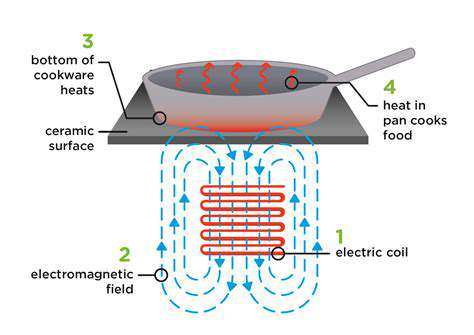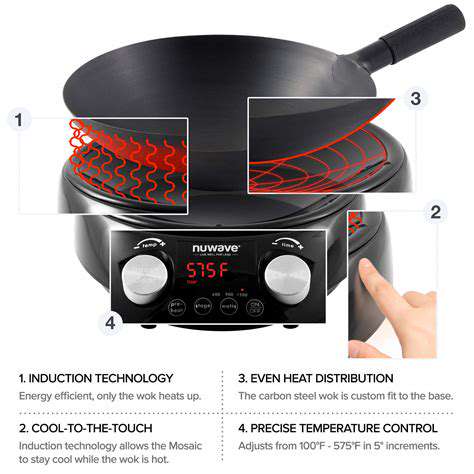Cooking with Induction Cooktop: Efficient and Precise

Electromagnetic Induction
Induction cooking utilizes a fascinating principle of electromagnetic induction. A rapidly fluctuating magnetic field, generated by the cooktop's electrical coils, is created beneath the cookware. This field induces eddy currents within the conductive metal of the pan. These eddy currents, in turn, generate heat within the pan itself, providing a remarkably efficient cooking method.
The Role of the Magnetic Field
The magnetic field is crucial to the induction process. It's not the heat source itself, but rather the intermediary that produces the heat within the cookware. This controlled magnetic field ensures that the heat is focused directly on the pan, minimizing energy loss to the surrounding environment. This focused heat source is a key factor in induction's efficiency.
Material Conductivity and Efficiency
The efficiency of induction cooking hinges significantly on the material properties of the cookware. Only magnetic materials, like iron, steel, and cast iron, can effectively generate the eddy currents necessary for induction cooking to work. Non-magnetic materials, such as copper or aluminum, do not respond to the magnetic field and therefore will not heat up using induction.
The Speed of Heating
Induction cooking often boasts a remarkable speed of heating. The direct application of heat to the pan, without the need for a hot surface, leads to a quicker response time to temperature changes. This rapid heating characteristic is often appreciated by cooks needing to quickly adjust the temperature or bring food to a boil.
Energy Efficiency and Safety
Induction cooking is generally recognized for its high energy efficiency. The targeted heating of the pan minimizes heat loss to the surrounding air, resulting in lower energy consumption compared to traditional cooking methods. Furthermore, induction cooktops are generally considered safer because the cooktop itself does not get as hot as other methods, reducing the risk of burns.
The Importance of Cookware Compatibility
A critical aspect of using induction cooking is ensuring the cookware is compatible. The cookware needs to be made of ferromagnetic materials to harness the induction process effectively. Using non-magnetic cookware on an induction cooktop will simply not work, and may potentially damage the cooktop or the cookware. Careful consideration of cookware material is essential to maximize the benefits of induction cooking.
Cleaning and Maintenance
Induction cooktops are generally easy to clean, as the heating element is contained beneath the surface. Spills and food residues are typically easier to wipe away than on traditional stovetops. Regular maintenance, such as checking for any damage to the cooking surface, is crucial to ensuring the longevity and proper functioning of the induction cooktop.
Choosing the Right Induction Cookware: A Key to Success
Understanding Induction Cooking
Induction cooking technology relies on electromagnetic fields to heat cookware directly, unlike traditional gas or electric methods. This means that only the cookware itself gets hot, not the surrounding elements. This efficient heating method leads to faster cooking times and precise temperature control, resulting in better overall cooking results. Understanding this fundamental principle is crucial for selecting the right induction cookware to optimize your culinary experience.
A key advantage of induction cooking is its energy efficiency. Since the heat is targeted directly at the cookware, there's minimal heat loss compared to other methods. This translates into significant energy savings over time, making induction cooking a more sustainable choice for environmentally conscious cooks. Furthermore, the rapid heating capabilities of induction cooking allow for Precise temperature control, a feature invaluable in many cooking techniques.
Matching Cookware to Your Needs
The type of induction cookware you choose should align with your cooking style and the types of dishes you frequently prepare. For example, if you primarily focus on stir-fries and quick-cooking meals, a set of induction-compatible pots and pans with various sizes might be ideal. However, if you're a dedicated baker, you might prioritize specific induction-compatible bakeware and cookware to ensure even heat distribution during extended baking periods.
Consider the material of the cookware. Cast iron, stainless steel, and even some non-stick materials are compatible with induction cooking. The material properties influence heat distribution and retention, impacting cooking results. Research the specific features of various cookware materials to find the best fit for your individual needs. This research will help you choose cookware that provides optimal performance and longevity.
Another important factor is the cookware's base. Induction cookware often has a specific magnetic base that facilitates the induction process. Ensure the base of your cookware is compatible with your induction cooktop to avoid any issues with heat distribution or cooking performance. The base's quality and design greatly affect the overall cooking experience and the efficiency of heat transfer.
Beyond the basic features, consider any special needs or preferences. For example, if you have specific dietary restrictions or cooking preferences, such as the need for non-stick surfaces or specific sizes for various cooking techniques, prioritize cookware that caters to these needs. Investing in well-designed and high-quality cookware will enhance your cooking experience and longevity.
Ultimately, careful consideration of your cooking habits and preferences will guide you toward the ideal induction cookware. This careful selection process will result in a cooking experience that is both efficient and enjoyable.
Precise Temperature Control and Faster Cooking Times: The Induction Advantage

Precise Temperature Control
Precise temperature control is crucial in many scientific and industrial applications. Maintaining a stable and accurate temperature is essential for ensuring consistent results, minimizing errors, and maximizing the efficiency of processes. This control is often achieved through sophisticated systems that monitor and adjust temperature in real-time, ensuring that the desired temperature is consistently maintained.
Precise temperature control is especially important in sensitive experiments and manufacturing processes. Variations in temperature can significantly impact the outcome, leading to inaccurate measurements, flawed products, or even safety hazards. Therefore, the ability to precisely regulate temperature is a critical factor in achieving desired results and maintaining quality standards.
Factors Influencing Temperature Control
Several factors can influence the effectiveness of temperature control systems. Environmental conditions, including ambient temperature fluctuations and air currents, can impact the stability of the controlled environment. Also, the thermal properties of the materials being controlled, such as specific heat capacity and thermal conductivity, play a significant role in how quickly and easily the temperature can be adjusted.
The design and implementation of the temperature control system itself are crucial. Choosing the appropriate sensors, actuators, and control algorithms is essential for achieving the desired level of precision and accuracy. Poorly calibrated equipment or inadequate control strategies can lead to instability and inaccurate temperature readings.
Types of Temperature Control Systems
A variety of temperature control systems exist, each with its own strengths and weaknesses. These systems can range from simple, standalone units to complex, integrated systems. Choosing the right system depends on the specific application and desired level of precision. Some common types include Peltier devices, thermoelectric coolers, and various types of heaters and chillers.
Applications of Precise Temperature Control
Precise temperature control finds applications in numerous fields. In laboratories, it's crucial for experiments involving biological samples, chemical reactions, and material analysis. In manufacturing, it ensures consistent quality in processes like semiconductor fabrication and pharmaceutical production.
Beyond these, it's vital in food processing, where maintaining precise temperatures is critical for food safety and quality. Accurate temperature control is also essential in various industrial processes like metalworking and heat treatment.
Challenges in Achieving Precise Temperature Control
Despite the importance of precise temperature control, several challenges remain. Maintaining a stable temperature in large or complex systems can be difficult. Also, achieving consistent temperature across different parts of the system can be a significant hurdle. Furthermore, ensuring long-term stability and reliability of the control system is a significant concern.
Maintenance and Calibration Procedures
Regular maintenance and calibration are essential for ensuring the continued accuracy and reliability of temperature control systems. Proper maintenance procedures, including cleaning and replacing worn parts, can help prevent malfunctions and maintain optimal performance. Calibration ensures that the system's readings accurately reflect the actual temperature. This is vital for ensuring the quality and safety of the processes that rely on accurate temperature readings.
Future Trends in Temperature Control
Advancements in sensor technology, control algorithms, and materials science are continually driving the development of more sophisticated and efficient temperature control systems. These advancements promise to enhance precision, reduce energy consumption, and expand the range of applications for temperature control. Smart sensors and automated systems are expected to play a crucial role in future temperature control solutions. Further integration with other technologies like data analytics will provide even more sophisticated control and monitoring capabilities.
Beyond Basic Cooking: Induction for Specialized Techniques

Induction Cooking: A Deeper Dive
Induction cooking, while seemingly simple, offers a wealth of advantages over traditional methods. It's incredibly responsive, allowing for precise temperature control and minimizing wasted energy by only heating the cookware, not the surrounding elements. This makes it perfect for a variety of culinary tasks, from delicate sauces to searing steaks.
The technology behind induction relies on electromagnetic fields to heat the cookware directly, resulting in rapid heating and a more even temperature distribution. This translates to faster cooking times and less energy consumption compared to gas or electric stoves.
Safety Features and Considerations
Induction cooktops are generally considered safe, but it's essential to understand the safety features and potential hazards. Proper cookware selection is critical for optimal performance and safety, as only magnetic cookware works with induction. Non-magnetic pans will not heat on an induction cooktop.
Always ensure the cookware is properly centered on the cooktop element to maximize the heating efficiency and prevent uneven cooking.
Choosing the Right Cookware
Selecting the right cookware is crucial for a smooth induction cooking experience. Look for cookware made from ferromagnetic materials like cast iron, stainless steel, or certain types of aluminum, as these materials are best suited for induction cooking. Ensure the cookware's base is flat and even to maximize contact with the cooktop.
Avoid using non-magnetic cookware, such as copper or nonstick pans with non-magnetic bases, on induction cooktops.
Maintenance and Cleaning
Induction cooktops are relatively easy to maintain and clean. Regular cleaning with a soft cloth and a mild detergent will keep the surface looking its best. Avoid using abrasive cleaners, which can scratch the smooth surface.
Be mindful of spills and promptly clean up any food residue to prevent potential damage to the cooktop.
Advanced Cooking Techniques
Induction cooking empowers chefs to explore advanced techniques with greater precision. The responsive nature of induction allows for delicate cooking methods like creating perfectly poached eggs or achieving precise temperature control during slow cooking.
Precise temperature control and rapid heating are key advantages for mastering various cooking techniques. This includes sautéing, stir-frying, and even baking, offering a wider range of culinary possibilities.
Cost and Benefits of Induction
While the initial cost of an induction cooktop might be higher than other types, the long-term benefits often outweigh the investment. Improved energy efficiency translates to lower energy bills over time, which can offset the initial cost. Induction cooking also enhances food quality and safety due to its uniform heating and precise temperature control.
The precise control and efficiency of induction cooking are valuable assets for home cooks and professional chefs alike.
Induction vs. Other Cooking Methods
Comparing induction to other cooking methods reveals significant advantages. Induction's responsiveness and precise temperature control offer a superior cooking experience compared to gas or electric. It's a more efficient cooking method, minimizing heat loss and maximizing energy use.
The reduced heat loss and precise control of induction cooking ultimately translate to better results and a more satisfying culinary experience.
Tips for Induction Cooking Success: Maximizing Your Experience
Choosing the Right Cookware
Selecting compatible cookware is crucial for induction cooking success. Induction cooktops work by generating heat through magnetic fields, so cookware must be made of ferromagnetic materials like iron, steel, or cast iron. Non-magnetic materials like aluminum, copper, or stainless steel won't work effectively, as they won't heat up. Look for cookware with a thick, magnetic base to ensure even heat distribution and prevent hot spots. This is vital for preventing uneven cooking and food burning.
Additionally, the size of your cookware should be appropriate for the cooktop. Using oversized pots and pans can lead to inefficient heat distribution, while using pots and pans that are too small might not allow the full heating capacity of the cooktop to be utilized. Matching the size of your cookware to the cooktop size will help maximize your induction cooking experience.
Understanding Induction Heat
Induction cooking differs significantly from traditional gas or electric cooking. Instead of heating the cooktop directly, induction generates heat within the cookware itself. This means that the heat source is not the cooktop, but rather the magnetic field interacting with the ferromagnetic material of your pot or pan. Understanding this principle is essential to preventing common mistakes and understanding why some cookware works better than others.
This unique heating mechanism leads to faster heating, more precise temperature control, and more efficient energy use. It also allows for a quicker response to temperature changes, enabling you to control the cooking process with greater accuracy.
Proper Placement and Alignment
Precise placement of your cookware is key to optimal performance on an induction cooktop. Ensure the bottom of your cookware is completely flat and centered on the cooking zone. Any misalignment can affect heat distribution and may lead to uneven cooking or the cooktop not recognizing the cookware at all. This is particularly important for cookware with slightly irregular bottoms. Correct positioning will ensure a consistent and even cooking experience.
Controlling Heat and Temperature
Induction cooktops offer exceptional temperature control, unlike traditional methods. The digital controls allow for precise adjustments, enabling you to maintain ideal temperatures for various cooking methods. This precision is vital for delicate dishes, where maintaining specific temperatures is paramount. This control also allows you to quickly adjust the heat to match the needs of your recipe.
Troubleshooting Common Issues
Occasionally, you might encounter problems with your induction cooktop. If your cookware isn't heating, ensure it's made of a ferromagnetic material and is properly centered on the cooktop. If you're still experiencing issues, consult the manufacturer's instructions or seek assistance from a qualified technician. Understanding the potential problems and how to address them will help maintain the functionality of your cooktop.
Maintenance and Safety Tips
Regular cleaning of your induction cooktop is essential to maintain its performance and prevent damage. Use a damp cloth and a mild detergent to remove spills and food residue. Avoid abrasive cleaners, as they can scratch the surface. This simple maintenance will ensure that your induction cooktop remains in optimal condition for years to come.
Always handle hot cookware with care. Use oven mitts to prevent burns. Also, be mindful of potential dangers, such as using incompatible cookware, which could lead to a malfunction or damage to the cooktop. Practicing safety precautions is crucial for a positive and safe induction cooking experience.
- Storing Rice and Grains: Pantry Best Practices
- How to Store Avocados: Ripening and Storing
- Oven Baked Dinners: Less Mess, More Flavor
- How to Store Potatoes Long Term: Cool and Dark
- Simple Chicken Breast Recipes: Versatile and Delicious
- Homemade Pizza Dough: The Ultimate Guide for Beginners
- Storing Garlic in a Cool, Dry Place: Best Practices
- Storing Fresh Produce: Optimal Conditions
- A Taste of Thailand: Authentic Pad Thai Recipe
- A Taste of Greece: Easy Souvlaki Recipe
- Authentic Vietnamese Pho Broth: Secrets to Flavor
- Kitchen Gadgets for Healthy Cooking: Smart Choices